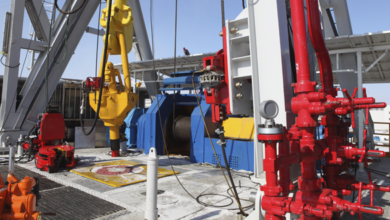Drilling Ahead
This time it’s different – again
By Mike Killalea, editor & publisher
This is the downturn everyone expected. They just didn’t expect it so soon. Anyone with a sense of history of the oil and gas business is wise to the reality that a ceaseless upward cycle just is not in the cards. The cards always come tumbling down.
We are experiencing the most sudden deterioration in commodity prices since 1982-83, just as a few months ago we witnessed unprecedented increases. But that earlier debacle shocked us. That’s because the then-mantra was of an endlessly expanding energy business – kind of like the Big Bang. I was a freshly minted, wet-between-the-ears petroleum engineer. The smart guys’ discourses on the industry’s positive outlook made sense. I bought it. Then the bottom fell out.
But the dynamics of the energy industry in the context of the overall economy have changed. In the late 1970s and 1980s, such prosperity as we D&C people enjoyed was much a function of politically driven supply constraints – embargoes and the like – and an imperfect understanding of the true supply picture – à la, “The world is running out of natural gas!”
In truth, energy prosperity was countercyclical to the robustness of the overall economy back then. DC’s website shows a graph with a remarkably close correlation of US unemployment vs annual inflation-adjusted oil price. As oil increases, so, after a beat, does unemployment. The reverse was also true.
This demonstrates what we already know: that much of the prosperity the world’s economic engine enjoyed was driven by cheap oil.
Our recent upturn, though, was driven, at least initially, by a real economic thirst for energy. Sure, political instability played a role. And speculation drove prices through the roof. But that was later.
So much for history. What do we do now?
PUT PEOPLE FIRST
The incessant drumbeat of layoffs has already begun sounding. Understandable, perhaps, but maybe not so wise in the long term. My information is that recruiting, hiring and training costs triple the expense of retention.
Not everyone has opted for knee-jerk personnel reductions. The IADC Career Connection program is returning to Fort Hood, Texas, for a Returning Military Campaign (RMC) job fair. A dozen IADC member companies intend to recruit at the largest transition base in the United States. It’s estimated that 2,000 soldiers will attend.
Also, a recent survey of DC readers on www.DrillingContractor.org reveals that 46% will either increase recruiting/training (14%) or continue at the same pace as earlier (32%).
Because the expectations for our industry are based on true economic demand in this new world, and it seems inevitable that real economic demand will awaken from hibernation, isn’t it reasonable to expect a return of robustness to our business? Please put people first. Let’s be ready for the upturn we expect.
For an expanded version of this column, go to www.DrillingContractor.org. You can reach Mike Killalea at mike.killalea@iadc.org.



